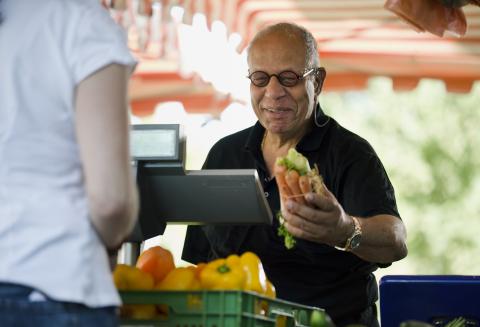Four Fresh Reasons to Shop the Farmer’s Market
Buy from your neighbors! There’s a reason it is sometimes called “community-supported agriculture.” When growers sell their produce themselves, they’re likely to take home more money than they’d get through a middleman. This difference can help them stay in business—and in many growing communities, it means they can keep their land growing crops rather than selling to developers. Studies have shown that buying from local growers can help people feel like a part of the community and give them the feeling that their spending reflects their values.
“It’s not just about the economical exchange; it’s a relational and ideological exchange as well,” says Ion Vasi, an associate professor with a joint appointment in the Department of Sociology and Tippie College of Business of the University of Iowa. “It’s about valuing the relationship with the farmers and people who produce the food and believing that how they produce the food aligns with your personal values.”
The freshest produce! Fruits and veggies at the grocery story may have traveled long and far before they show up on the shelf. This distance is sometimes referred to as “food miles.” When varieties of produce are grown, packaged and treated to survive the journey, taste and quality can suffer from the trip. Because their produce doesn’t have to be shipped or spend time in a storehouse, farmer’s market vendors are also able to grow succulent, more delicate varieties of fruits and veggies. A grocery store tomato vs. one that’s right off the vine? No contest!
The most value for your dollar! When a certain crop is ready for harvest, it’s ready right then, and a vendor may have it in abundance! For example, this time of year many tomatoes are at their moment of absolute perfection. Make sauce! Buy a big basket of cucumbers and make pickles. Take home a huge bunch of basil and make pesto. Food that is frozen at its peak harvest time can be enjoyed later and still maintain that fresh harvest flavor.
Far more than fruits and veggies! Fresh produce is the true heart of a farmers market, but vendors also sell baked goods, yummy sauces and jams prepared in small batches, honey, freshly foraged mushrooms, and artisanal cheeses. And you may find gorgeous plants and cut flowers at a fraction of what you’d pay at a florist. Vendors of many ethnic backgrounds might be selling new treats you’ve never tried! What’s that little cucumber? Is that pepper spicy? Are those little fruits a relative of raspberries? Vendors often offer advice and recipes. Maybe you’ll find out the name of the little goat who contributed to that chèvre cheese you love!
Most farmer’s markets are outdoors, making them a safer shopping venue for older adults these days. This can be a great outing with a nutritional payoff! Be sure to thoroughly wash your produce and properly store your prepared foods, as older adults may be at an increased risk of food-borne pathogens.
